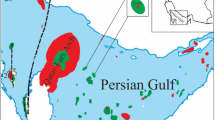Abstract
The geological attributes, the nature of permeability barriers, and petrophysical properties are substantial for defining the different hydraulic units which do not necessarily coincide with the geological facies boundaries. The integrated study between facies analysis and classic discrimination of hydraulic flow units is very important to categorise rock quality and heterogeneity as a reservoir. The lithofacies and petrographic microfacies analyses are carried out based on subjective geological observations, whereas the graphical and statistical hydraulic flow unit discriminations are carried out based on permeability-porosity empirical relationships. The reservoir quality heterogeneity is in charge of characterising the hazard in delineating a new discovery in the field. In this study, the authors defined and described five facies (F1, F2, F3, F4 and F5) in light of the geological attributes of the Jurassic rocks at Khashm El-Galala. Facies F5, which is coarse to medium-grained quartz arenite sandstone, represents the best reservoir quality. Three hydraulic flow units (HFU1 through HFU3) were described precisely in the studied rocks with flow zone indicator (FZI) values referring to a wide range of hydraulic characteristics. Quartz constitutes the dominant framework mineral in the sandstone samples. Compaction and cementation are the most effective porosity-reducing diagenetic processes that change the reservoir rock quality.













Similar content being viewed by others
Explore related subjects
Discover the latest articles and news from researchers in related subjects, suggested using machine learning.References
Abd El-Shafy E (1980) Lithostratigraphy and biostratigraphy of Jurassic rocks at Gulf of Suez, Egypt, PhD. Thesis, Geology Dept., Fac. Sci., Zagazig Univ., Egypt
Abdallah AM (1961) New findings of interest on the geology of the western side of the Gulf of Suez, J. Geology. UAR 5(1):55–68
Abdallah AM (1964) New Bathonian (Middle Jurassic) Occurrence at the western side of the Gulf of Suez, Egypt, Geol. Surv. and Min. Res. Depart, Cairo
Abdallah AM, Fahmy N (1969) A new Pelecypod subgenus and species from Middle Jurassic of Khashm El-Galala, Gulf of Suez. Egypt J Geol UAR, Cairo, Egypt 13(2):145–151
Abdallah AM, Wahab SA, Aboul Ela N, El-Azhary T (1979) Sedimentary structures in the Permo-Carboniferous Aheimer and Abu- Darag formations, west Gulf of Suez, Egypt, Annual of Geol. Surv Egypt IV:432–445
Abuseda H, Kassab MA, Lala AM, El Sayed NA (2015) Integrated petrographical and petrophysical studies of some Eocene carbonate rocks, Southwest Sinai, Egypt, Egyptian Journal of Petroleum, Elsevier 24: 213–230
Amaefule JO, Altunbay M, Tiab D, Kersey DG, Keelan DK (1993) Enhanced reservoir description: Using core and log data to identify hydraulic flow units and predict permeability in uncored intervals/wells. Society of Petroleum Engineers, paper 26436, 88th Annual Technical Conference and Exhibition, 205–220
Amyx JW, Bass DM, Whiting RL (1960) Petroleum Reservoir Engineering. McGraw Hill Publ. Co., New York, NY
Djebbar T, Donaldson EC (2004) Theory and Practice of Measuring Reservoir Rock and Fluid Transport Properties, seconded. Burlington, USA
Farag IAM (1941) The Jurassic Formations in Egypt, PhD. Thesis, Cairo Univ., Giza
Füchtbaur H, Müller G (1970) Sedimente und sedimentgesteine, schweizer bratsch verlag. Stuttgart
Hassanein MI (1984) Geological studies of the Jurassic rocks in northern Galala, gulf of Suez, Egypt, M. Sc. Thesis, Fac. Sci., Cairo Univ., Egypt
Irland HA (1971) Insoluble residues, In Craver, R.E. (edit.) procedures in sedimentary petrology John Wiley Intersciences, New York, pp 479–498
Kassab MA, Teama MA, Cheadle BA, El-Din ES, Mohamed IF, Mesbah MA (2015) Reservoir characterization of the Lower Abu Madi formation using core analysis data: El-Wastani gas field, Egypt. J Afric Earth Sci, Elsevier 110:116–130
Kassab MA, Abdou AA, El Gendy NH, Shehata MG, Abuhagaza AA (2017) Reservoir characteristics of some cretaceous sandstones, North Western Desert, Egypt. Egypt J Pet 26:391–403
McQueen and Martin (1931) Insoluble residues as a guide in stratigraphic studies, Missouri. Geol- Surv- 56 th Biemn Rep. State Geologist Apr. 1:103–131
Said R (1962) The Geology of Egypt. Elsevier, Amsterdam, New York
Said R (1990) The Geology of Egypt. Balkema, Rotterdam
Acknowledgements
Mostafa Teama would like to thank the Egyptian Petroleum Research Institute (EPRI) CoreLab, Ministry of Scientific Research, Egypt, for access to lab facilities for conducting part of this work. The authors would like to thank those who offered help during sample preparation, measurements and data interpretation.
Author information
Authors and Affiliations
Corresponding author
Additional information
Highlights
• Our main aim is to study the effect of petrophysical parameters on reservoir quality.
• Reservoir quality of our sandstones was controlled by type diagenetic processes and facies dominated.
• Facies 5 is the dominant in HFU3 and characterized by good petrophysical properties.
Rights and permissions
About this article
Cite this article
Kassab, M.A., Teama, M.A. Hydraulic flow unit and facies analysis integrated study for reservoir characterisation: a case study of Middle Jurassic rocks at Khashm El-Galala, Gulf of Suez, Egypt. Arab J Geosci 11, 294 (2018). https://doi.org/10.1007/s12517-018-3595-2
Received:
Accepted:
Published:
DOI: https://doi.org/10.1007/s12517-018-3595-2
Keywords
Profiles
- Mostafa A. Teama View author profile




